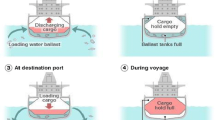Abstract
This study proposes the conceptual design of an offshore liquefied natural gas (LNG) bunkering terminal that would play a critical role in the LNG supply chain for LNG-fueled ship propulsion. The principal functions of the LNG bunkering terminal include importing LNG from LNG carriers, storing it temporarily, and exporting the stored LNG to LNG bunkering shuttles or LNG-fueled ships. One of the critical issues facing cargo operation from a safety point of view is the treatment of boil-off gas (BOG) generated from several sources in the storage systems of the bunkering terminal. Several methods of handling BOG seem feasible. The employment of a pressure vessel with a re-liquefaction system is considered the most effective and safe alternative. As a case study, a conceptual design of Busan Port is carried out by analyzing the statistics of visiting ships, estimating the required LNG consumption, determining the hull structure, and anticipating the design cases. The results obtained include the number of target LNG-fueled ships and LNG bunkering shuttles, LNG demand, capacity, and type of hull structure for the bunkering terminal. To estimate the process specifications and equipment features of the topside system, the BOG generated from several sources is calculated.




Similar content being viewed by others
Abbreviations
- BOG:
-
Boil-off gas
- BPA:
-
Busan Port authority
- CAPEX:
-
Capital expenditure
- ECAs:
-
Emission control areas
- EEDI:
-
Energy efficiency design index
- GBS:
-
Gravity-based structure
- GHG:
-
Greenhouse gas
- GT:
-
Gross tonnage
- HFO:
-
Heavy fuel oil
- Hs:
-
Significant wave height
- HT LNG:
-
High-temperature liquefied natural gas
- IGC:
-
International code for the construction and equipment of ships carrying liquefied gases in bulk
- IMO:
-
International maritime organization
- LCC:
-
Life cycle cost
- LNGC:
-
LNG carrier
- LNG-BS:
-
LNG bunkering shuttle
- LNG-BT:
-
LNG bunkering terminal
- LNG-RS:
-
LNG receiving ship
- LOA:
-
Length over all
- LT LNG:
-
Low-temperature liquefied natural gas
- MARPOL:
-
International convention for the prevention of pollution from ships
- MEPC:
-
Marine environment protection committee
- NG:
-
Natural gas
- OCIMF:
-
Oil companies international marine forum
- OPEX:
-
Operating expenditure
- PM:
-
Particulate matters
- SOLAS:
-
International convention for the safety of life at sea
- STS:
-
Ship-to-ship
- TEU:
-
Twenty-foot equivalent unit
- VLCC:
-
Very large crude oil carrier
References
IMO (2009) Regulations for the prevention of air pollution from ships. Revised MARPOL Annex VI
Devanney J (2011) The impact of the energy design index on very large crude carrier design and CO2 emissions. Ships Offshore Struct 6:355–368
Det Norske Veritas AS, MAN Diesel and Turbo (2011) Quantum 9000 two stroke LNG
Graham B (2012) Innovation in the LNG Value Chain. Increasing the Uptake of LNG as a Transportation Fuel
Dongkyu C (2011) Shipyard’s perspective; ship design-LNG propulsion systems. CIMAC 2011, Oslo, Norway, 26 May 2011
Excelerate energy (2007) LNG ship-to-ship transfer. LNG Transshipping conference, Houston, USA, 25 January, 2007
Kawasaki Heavy Industries Ltd (2012) Concept design of LNG bunkering ship. The 6th Asian shipbuilding expert’s forum, Guangzhou, November 2012
Manjin J, Joseph HC, Wungsang R (2003) LNG terminal design feedback from operator’s practical improvements. The 22nd World Gas Congress, Tokyo, Japan, 2003
McGuire W (2000) Liquefied gas handling principles on ships and in terminals, 3rd edn. SIGTTO, England, pp 112–146
Wim van W, Hein O, Jos van der H (2004) Offshore LNG terminal: sunk or floating?. OTC 2004, Houston, USA, 3–6 May 2004
Korea Hydrographic and Oceanographic Administration (2010–2012) Report of real-time Korea oceanographic observations and extreme highest and lowest tide level in Busan
Korea Meteorological Administration (2002–2011) Annual climatological report
International Convention for the Safety of Life at Sea (1960) Chapter 3: design criteria applicable to all ships
International Code for the Construction and Equipment for Ships Carrying Liquefied Gases in Bulk (2006) Chapter. 15: filling limits for cargo tanks
Tor EB, Joachim B (2008) Ship-to-ship LNG transfer in arctic waters. OMAE 2008, Estoril, Portugal, 15–20 June 2008
Busan Port Authority (2011) Ship statistics in Busan port
Adriatic LNG (2010) Adriatic LNG Media Relations
Madison Wiley Barron (1992) Ekofisk Tank Protective Barrier. Construction Innovation Forum
Seyedalizadeh SRG, Babazadeh A, Arabshahi N (2010) Analysis of the continuous berth allocation problem in container ports using a genetic algorithm. J Mar Sci Technol 15:146–408
Acknowledgment
This research was supported by a grant from the LNG Plant R&D Center funded by the Ministry of Land, Infrastructure and Transport of the Korea government.
Author information
Authors and Affiliations
Corresponding author
About this article
Cite this article
Yun, S., Ryu, J., Seo, S. et al. Conceptual design of an offshore LNG bunkering terminal: a case study of Busan Port. J Mar Sci Technol 20, 226–237 (2015). https://doi.org/10.1007/s00773-014-0266-1
Received:
Accepted:
Published:
Issue Date:
DOI: https://doi.org/10.1007/s00773-014-0266-1




